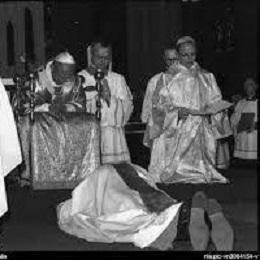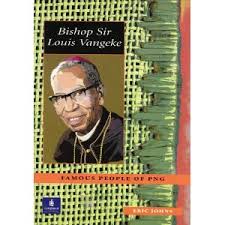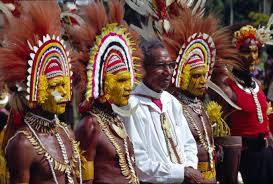Into the PNG MSC Archives, Bishop Louis Vangeke MSC
The anniversary of the ordination as priest, 1937, of Louis Vangeke MSC, the first Papua-New Guinean Catholic priest and bishop.

Sir Louis Vangeke, M.S.C. KBE (1904–1982) was a Papua New Guinean prelate of the Catholic Church who served as the bishop of the Diocese of Bereina in Papua New Guinea from 1976 to 1979. Prior to that he was the auxiliary bishop of the Archdiocese of Port Moresby, also in Papua New Guinea. Vangeke was consecrated as a bishop on 3 December 1970 by Pope Paul VI at St Mary's Cathedral in Sydney, Australia. He was the first indigenous Papua New Guinean Catholic bishop. Vangeke died in 1982, aged 78. [His Wikipedia entry]

On 3 December 1970 he became the first Papua New Guinean Catholic bishop. In Sydney Pope Paul VI consecrated him titular bishop of Culusi, but he was made only auxiliary bishop of Port Moresby because some European priests were wary of serving under a ‘native’ and because he seemed to lack the administrative skills, although certainly not the spirituality, needed for an episcopal role. At Beipa’a he was installed as a chief; thousands of people witnessed a syncretic ceremony in a temporary ufu (ceremonial hall). Vangeke said he was now ‘a sorcerer for God’ while his nephew, who inherited Louis’s father’s ‘sorcerer’s box’, was there as his ungaunga (protector) to ward off Satan.

In 1976 Vangeke was promoted bishop at Bereina, where he spent the rest of his life. Although he had spoken against early independence for Papua New Guinea, he was appointed OBE in 1974 and KBE in 1980. In 1976 the University of Papua New Guinea conferred on him an honorary LL.D and, that year, five ministers offered to nominate him to be governor-general. He declined because, he said, of ecclesiastical duties but really because, temperamentally, he was neither ambitious nor attracted by secular ostentation. Sir Louis died on 15 December 1982 at Beipa’a and was buried there. A Church spokesman stressed his deep humility and said he was ‘a great man and a great inspiration to Papua New Guinea’. [From James Griffin entry, Australian Dictionary of Biography.]